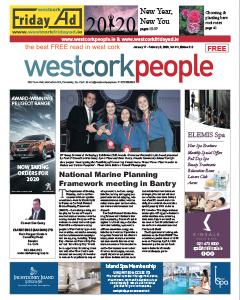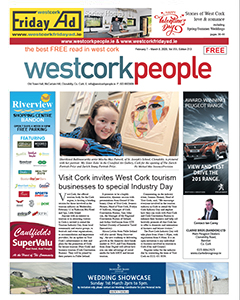After suffering a severe spinal injury last May, Clodagh Helen, 25, from Clonakilty, is undertaking a remarkable feat in aid of Spinal Injuries Ireland. The determined zoo biologist, who is one of the handlers at the Birds of Prey Centre at Aillwee Cave in Co. Clare has set herself the challenge of climbing to the highest point in every county of Ireland within one year of breaking her back. She tells Mary O’Brien about her recovery and why she has set herself such a hard task.
On May 31, 2018, Clodagh Helen suffered a fall from a horse while out riding. Although she was wearing a back protector, the way in which she landed meant that her spine was violently compressed from the impact, causing her T12 vertebrae to burst and fracture in several places. She also tore ligaments in her left ankle.
What followed was a long rehabilitation period and complete dependence on the people around her for several months. For a long time, Clodagh was too weak to even lift a pint of water. Most likely, the young zoo biologist will have permanent but manageable pain for the rest of her life. Clodagh returned to work in a limited capacity in October and is determined that she will return to the same level of strength and fitness that she enjoyed before the accident.
Advised to not yet return to any strenuous, high impact activity, Clodagh explains that she’s attempting this challenge simply because she can and as a celebration of her recovery. “One of the only ways I can build my fitness is to walk,” she says. “If all I did was work and lie around, I would very quickly become angry with the disability and focus on what I can’t do yet. Hiking is something I have always loved, and at the moment I need something goal based and progressive, which is exactly what the County Tops Challenge is.
By starting with the smaller, easier peaks, Clodagh is building herself up to the more demanding summits such as Carrauntoohil, the Connemara mountains and Wicklow’s Lugnaquilla. “After completing the first two, a friend mentioned how great she thought it was and it would definitely be something people would sponsor me for. Doing it for a charity also drives and encourages me, as the world now knows my deadline! Although I will admit, I will be under huge time pressure to get them all done…16 left to do in four months!”
Most of Clodagh’s charity work in the past has been for wildlife, as she is so passionate about the natural world, but after doing some research she came across the charity Spinal Injuries Ireland.
“It is the only support agency in Ireland for people who have sustained a spinal cord injury and their families,” she explains. “I was so fortunate to not have damaged my spinal cord, yet it could easily have been a reality. If I had fallen even the smallest degree at a different angle, it could have been me and my family needing vast amounts of support. Such an injury is one of the most life altering experiences; and I got a glimpse of how hard it must be to come to terms with the consequences.”
Clodagh says that the accident initially changed every aspect of her life. “Until it causes trouble, we don’t realise how everything we do goes through our spine; we have no strength without it,” she says.
“For the first week after the accident, I was in the trauma ward at UHL lying flat without even the comfort of a pillow. The first few days, I had a neck brace to keep my spine stable, and once it was taken off I understood that if I tried to move I could potentially be paralysed.
“It was a very long week of bed pans, catheters, pressure sores, xrays, CT scans and MRIs unsure of what the outcome would be.
“Six days after the accident, the consultants, after deliberation and discussion with spinal specialists in Dublin, decided I did not need surgery. A TLSO (Thoracic Lumbar Sacral Orthosis) brace was fitted and I could finally move. This was actually an incredibly difficult transition; after lying flat and still for so long, I suffered from severe vertigo and my balance was hugely affected. I was given control of my bed, raising it to a seated position centimetres at a time; stopping it when the dizziness and nausea were about to make me pass out. Eventually I made my few very wobbly first steps from my bed to a wheelchair so I could abandon the catheter and bedpan, and be wheeled to the bathroom! Here lay more problems; such a sedentary state combined with all sorts of medication had played havoc on my digestive system…I won’t go into the details!”
Clodagh has patchy memories from her time in hospital, where she was in a lot of pain. “Whether this was due to pain or the medication, I can’t say. But I have no recollection of some visitors who called; photographs I smiled for that I don’t remember being taken; or the morphine injection I apparently got under my tongue. I vividly remember hallucinations during my stay; a side effect of some of the drugs. When the nurses asked, on a scale of one-10, what was my pain level, I never said higher than seven. After recently discovering the definition of the numbers on the scale, I was a nine and 10 every day!”
Once the TLSO brace was fitted, and Clodagh could demonstrate a very slow ascent and descent on a stairs, she was discharged from hospital. “Of course, my fantastic parents wouldn’t hear of me going anywhere except home to them in Clonakilty, and after I survived the painful drive from Limerick I was welcomed home to a bed for me in the living room!”
As she spent 90 per cent of her time lying down for the next few months, this proved a brilliant idea from her mom, as it allowed Clodagh to chat with visitors amd family from her bed, as they sat at the kitchen table. “I was absolutely overwhelmed by the number of neighbours, friends, and family who called to wish me well, some who I hadn’t seen in years.”
Gradually, the pain lessened and Clodagh’s strength improved. She went from spending most of her day in bed to moving between there and a sun lounger in the garden and being able to walk back to the family farm to see how things were there. “Two of my cousins were getting married that summer and it was great to be at home amid all the buzz and preparations, even if it was stretched out on the couch being a spectator. I was so proud of myself to be able to stand as bridesmaid for one and so delighted that she didn’t mind an ugly brace in her pictures…the dressmaker did a wonderful job!”
By August, Clodagh was pretty strong. “I was able to help around the house a bit and my father found me very handy on the farm for small jobs.”
The brace came off 12 weeks after the accident. “For several weeks, I put the brace on and off, weaning myself off it. It had acted as my core support for so long, my muscle had wasted away,” explains Clodagh.
She was allowed to drive when not wearing the brace but even now she finds sitting and driving the most painful position to be in. She started physiotherapy, which is still ongoing. “I’m hoping to be able to touch my toes one of these days!” she says.
Advised to join a pilates class in November, she finds this very tough going, but is surprised at how quickly her strength is returning. “I was so fortunate to be very fit and healthy before the accident, which made the recovery easier.” she says.
As well as being a very physical injury, it also takes it’s toll emotionally. “I would have always been the kind of person who bottles their feelings and could distance myself emotionally from upsetting situations. From someone who would rarely cry, I have become the opposite,” explains Clodagh. “When I talk about the accident and the aftermath, I can’t still can’t stop the tears. Even when I’m alone, something relating to the experience will pop into my head and I will be in floods of tears. I think it’s all coming out now, because when it actually happened I was full of smiles and laughter and telling myself it would be grand.
“It was a time of extreme highs and extreme lows. Overwhelming emotions. No matter how ill I felt, I would wiggle my toes and pure happiness would distract me from the pain and suffering. I was strong because I knew things would improve; it was a ‘fixable’ injury, and that was all that mattered.
“I don’t think I’ll ever be able to repay or thank all of my family and friends and the hospital staff for what they did for me; and are still doing! I have them all roped in to climb a mountain or two!”
Clodagh is planning to climb Knockboy; Cork’s county high point on Saturday, February 2. If anyone would like to join her on a hike, she would be delighted to have the company! All you have to do is message the facebook page.
“I hope I’ll be leading an army up the mountain in Cork!” she says with a smile.
You can support Clodagh’s County Top Challenge for Spinal Injuries Ireland by visiting https://gogetfunding.com/clodaghs-county-top-challenge-for-spinal-injuries-ireland/
For more information on any of her upcoming hikes go to
E clodaghschallenge



